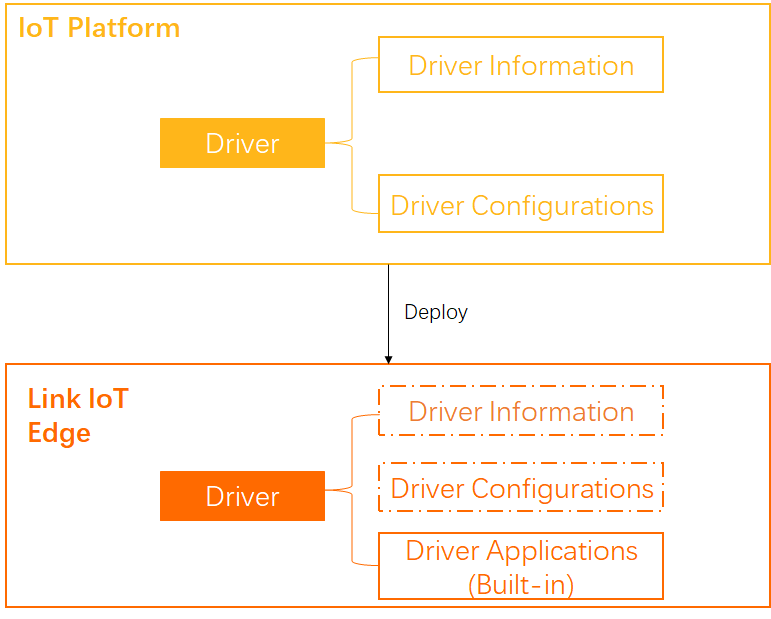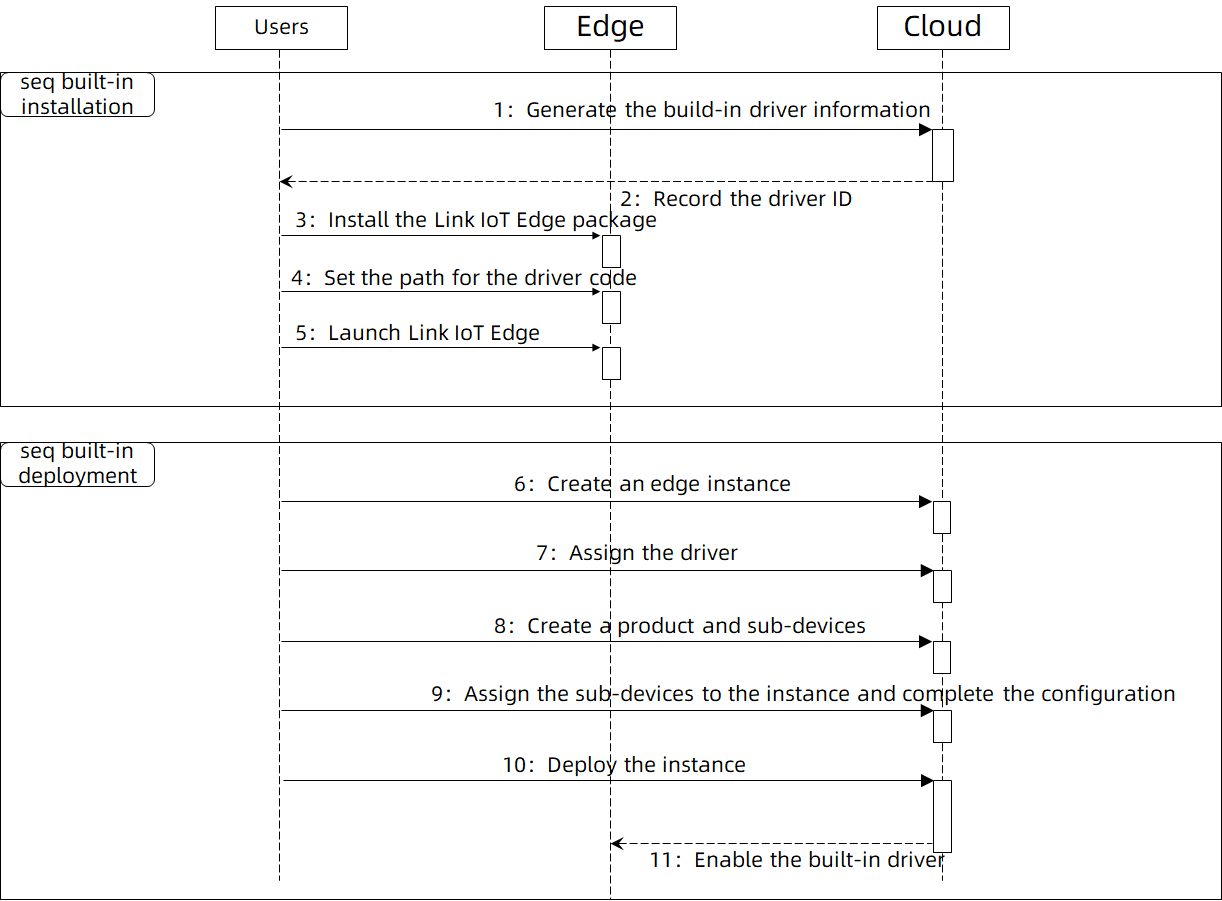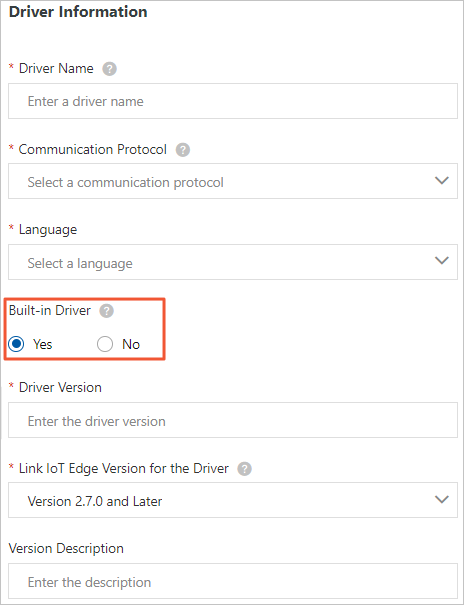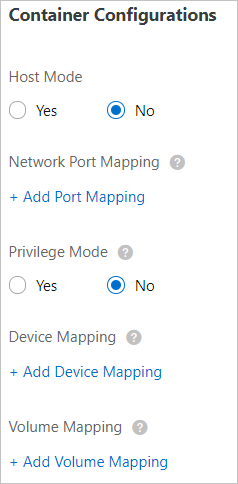Link IoT Edge allows you to deploy built-in drivers to your gateway. This feature allows you to manage the on-premises driver files, configure the drivers in the cloud, and then deploy the drivers to the edge.
Prerequisites
A built-in driver that complies with the driver specifications of Link IoT Edge is provided. For more information, see Develop drivers.Background information
Link IoT Edge supports the use of built-in drivers. You can upload built-in drivers to your gateway. Then, you can configure driver information and channels, and devices in the cloud. The driver information may contain the driver name, coding language, runtime environment, and hardware architecture.

1. Procedure in the cloud
- Log on to the Link IoT Edge console. In the left-side navigation pane, click Drivers.
- On the Drivers page, click the Custom Drivers tab. On the Custom Drivers tab, click Create Driver.
- On the Create Driver page, set the parameters as prompted.
- Driver Information

Table 1. Parameters Parameter Description Driver Name The name of the custom driver. The name must be 1 to 20 characters in length, and can contain letters, digits, and underscores (_). The name must start with a letter. Communication Protocol The communication protocol that is used to develop the driver. Valid values: Modbus, OPCUA, and Custom. Language The programming language that is used to develop the driver. Valid values: Node.js 8, Python 3.5, C, and Java 8. If you set the Language parameter to C, you must set the CPU Architecture parameter.
Built-in Driver Specifies whether the driver is built-in. - Yes: An on-premises built-in driver is used. You do not need to upload a driver file.
- No: You must upload a driver file and deploy the driver in the cloud. For more information, see Publish drivers to the cloud.
To publish a built-in driver, you must select Yes.
Driver Version The unique version number of the driver. You cannot specify two identical version numbers for a driver. Link IoT Edge Version for the Driver The Link IoT Edge version that supports the driver. The driver can run only in the gateways for Link IoT Edge of the specified version or later. Version Description Optional. The description of the driver version. - Driver Configurations

Table 2. Parameters of driver configurations Parameter Description Configuration Format The configuration method. Valid values: - Key-value Configuration
- JSON Format
- Configuration File
Configuration Format: Key-value Configuration If you select Key-value Configuration, click Add Configuration. Then, set the Configuration Name, Value, and Description parameters to configure the driver. You can add a maximum of 100 key-value pairs.
Configuration Format: JSON Format If you select JSON Format, enter JSON-formatted data to configure the driver. The data size cannot exceed 1 KB. Link IoT Edge automatically verifies the format. If the format is invalid, modify the JSON-formatted data as prompted. Configuration Format: Configuration File If you select Configuration File, edit a configuration file on your computer and upload it to the Link IoT Edge console. - Container Configurations

Parameter Description Host Mode Specifies whether to isolate the container network from the host network. Valid values: - Yes: The container network is the same as the host network.
- No: The container network is isolated from the host network. If you select this option, you must set the Network Port Mapping parameter.
Network Port Mapping The mappings between host network ports and container network ports. This parameter is available only when you set the Host Mode parameter to No. The network where the function runs is isolated from the host network. You can map the listening port of the function in the container to a host network port. This allows client programs on various hosts to access the services that are provided by the function. You can specify a maximum of 10 entries. For example, the
fc-http-serverfunction runs in a host container, and provides services by using Port 80. The client programs on other hosts cannot access thefc-http-serverfunction by accessing Port 80 on the current host. To enable the client programs on other hosts to access thefc-http-serverfunction, you must map Port 80 in the container where the function runs to a host network port, such as Port 8080. Then, the client programs on other hosts can accessIP address:port 8080on the host network, and use the services provided by thefc-http-serverfunction.Privilege Mode Specifies whether to enable the privilege mode. Root users of containers can access host services only as regular users. If you need to change the system time or run the mount command in containers, you must be granted the required root permissions. In this scenario, you must enable the privilege mode for the containers.
Note If you enable the privilege mode, applications and programs in the containers are granted the host root permissions, and all the host devices are mapped to the containers. Therefore, you do not need to set the Device Mapping parameter.Device Mapping The device mappings. This parameter is available only when you set the Privilege Mode parameter to No. The network where the device management system resides is isolated from the host network. To enable a function to access a host device such as a serial port, you must map the device to the container where the function runs. You can specify a maximum of 10 entries. Volume Mapping The volume mappings. The network where the file system resides is isolated from the host network. To enable a function to access a host file, you must map the file to the container where the function runs. You can specify a maximum of 10 entries. - Configuration Verification

Table 3. Parameters Parameter Description Driver Configurations If you select Driver Configurations, you must complete driver configurations before you can deploy the edge instance. The driver configurations are specified after the driver is assigned to an edge instance and sub-devices are assigned to the driver. Device Configurations If you select Device Configurations, you must complete device configurations before you can deploy the edge instance. The device configurations are specified after the driver is assigned to an edge instance and sub-devices are assigned to the driver.
- Driver Information
- After the parameters are set, click Confirm. The driver that you created is displayed on the Custom Drivers tab.

You can move the pointer over the driver name to view the driver ID. Click Copy and save the driver ID, which will be used in subsequent steps.
2. Procedure at the edge
Link IoT Edge provides the led_driver sample driver. For more information, visit led_driver source code. You can use the sample driver for testing and debugging.
- Create an edge instance and connect the edge gateway to Link IoT Edge. For more information, see Set up environments.
- Log on to the gateway and run the following command to create a driver directory:
sudo -E mkdir -p /linkedge/pre-installed/ - Run the following command to create a folder with built-in drivers. Save the driver files and dependent libraries that you have prepared in the Prerequisites section to this folder.
sudo -E mkdir -p /linkedge/pre-installed/{your_driver_name}/{your_driver_name} is the name of your driver. For example, if the driver name is led_driver, the following command is used:
sudo -E mkdir -p /linkedge/pre-installed/led_driver/ - Check whether the following built-in driver tools are installed on the gateway.
Tool Function sed Finds and replaces the content of text files. jq Parses JSON files. base64 Provides Base64 encoding. - Optional. If the gateway does not have tools such as sed, jq, or base64, you must perform the following steps to ensure that the shell script tool for the built-in driver runs as expected:
- In the built-in driver folder, download and decompress the shell script tool for built-in drivers. The following code shows the directory structure of the script tool after decompression.
. └── led_driver |-- pre-installed.sh |-- lib └── main - Go to the directory where the built-in driver is located and run the shell script tool.
cd /linkedge/pre-installed/{your_driver_name}/ sudo -E ./pre-installed.sh {your_driver_id} --default{your_driver_name} is the driver name and {your_driver_id} is the driver ID that you saved in the Procedure in the cloud section of this topic.
For example, the driver name is led_driver and the driver ID is f16f13322***********3959cf3. In this case, the following command is run:
cd /linkedge/pre-installed/led_driver/ sudo -E ./pre-installed.sh f16f13322**********3959cf3 - Assign the built-in driver to the edge instance and deploy the edge instance to complete the process of publishing the build-in driver. For more information, see Debug drivers.
FAQ
Q: Why do my devices not come online after I run the shell script?
A: You must complete the driver configuration in the cloud and deploy the driver to the gateway before the associated sub-devices can come online.
Related operations
- Log on to the Link IoT Edge console.
- In the left-side navigation pane, click Drivers.
- On the Custom Drivers tab of the Drivers page, click Version Management in the Actions column.

- In the Version Management panel, you can manage the driver versions. The following table describes the available operations.
Operation Description Create Version You can click Create Version to create a version of the driver. For more information about the configurations and parameters, see the Procedure in the cloud section of this topic. Publish You can click Publish to publish the specified version. In the Publish Driver dialog box, confirm the driver information and click Publish. Note After the version of the driver is published, you cannot delete the version of the driver. You can only view the version details or download the version of the driver.Edit You can edit the driver configurations only when the driver version is in the Unpublished state. Click Edit to edit the driver configurations. For more information about the parameters, see the Procedure in the cloud section of this topic. Download You can click Download to download the specified version of the driver. Delete You can delete a driver version only when the driver version is in the Unpublished state. Click Delete to delete the specified version of the driver. View You can view the driver version details only when the driver version is in the Published state. Click View to view the driver version details, or modify the configurations of the driver version. For more information, see the Procedure in the cloud section of this topic. - After you publish the driver in the cloud, you can assign the driver to an edge instance and assign sub-devices to the driver. Then, you can deploy the driver and its sub-devices to the edge by deploying the edge instance. For more information, see Debug drivers.